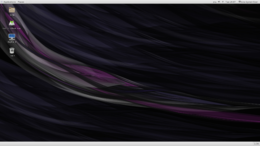Scientific Linux
Da Wikipedia, l'enciclopedia libera.
| Scientific Linux sistema operativo | |
|---|---|
  | |
| Sviluppatore | Fermi National Accelerator Laboratory / European Organization for Nuclear Research (CERN) |
| Famiglia | Linux |
| Release corrente | 7.9 (20 ottobre 2020) |
| Tipo di kernel | Kernel monolitico |
| Piattaforme supportate | x86, x86-64 |
| Tipo licenza | Software libero |
| Licenza | GPL |
| Stadio di sviluppo | Sviluppo continuo |
| Sito web | www.scientificlinux.org |
Scientific Linux è una distribuzione GNU/Linux, sviluppata dal Fermilab, dal CERN, dal DESY e dal ETHZ che mira ad essere compatibile al 100% con i pacchetti basati su .rpm e su Red Hat.
Questa distribuzione è basata sul software libero reso disponibile da Red Hat, ma non è prodotta, mantenuta o supportata da Red Hat inc. Più precisamente, essa è basata sul codice sorgente di Red Hat Enterprise Linux, sotto i termini e le condizioni della Red Hat Enterprise Linux's EULA e della GNU General Public License.
Storia
[modifica | modifica wikitesto]Il Fermilab aveva già creato una distribuzione Linux conosciuta col nome di Fermi Linux LTS 3.0.1, basata su RHEL. Nel frattempo, il CERN stava sviluppando la versione successiva di Cern Linux, anch'essa basata su RHEL. Fu il CERN a proporre al Fermilab di unire gli sforzi; Connie Sieh, la principale sviluppatrice di Fermi Linux, si rese conto del potenziale di questa collaborazione[senza fonte], prevedendo che del progetto avrebbero beneficiato non solo i due grandi centri di ricerca, ma anche una moltitudine di piccoli laboratori. Sieh è stata la principale sviluppatrice, guidando lo sviluppo dei primi prototipi e delle release iniziali.
Il primo prototipo fu chiamato HEPL, ossia High Energy Physics Linux, e fu accolto favorevolmente dalla comunità scientifica. Molti espressero tuttavia insoddisfazione per quanto riguardava la scelta del nome, in quanto non tutti gli utenti si occupavano di fisica delle alte energie[1]. Il nome fu quindi cambiato in Scientific Linux. La prima release ufficiale risale al 10 maggio 2004.
Con la distribuzione di Scientific Linux 3.0.1, il CERN iniziò a collaborare e divenne co-sviluppatore della distribuzione.
Scientific Linux include software utile per gli scienziati ed in generale per chi lavora con dati scientifici; alcuni esempi sono le librerie FITS, Graphviz.
Versioni
[modifica | modifica wikitesto]Si elencano di seguito le versioni distribuite:
| data-mese-anno | Numero (Ufficiale) | Nome |
|---|---|---|
| 10-05-2004 | Scientific Linux 3.0.1 | Feynman |
| 28-06-2004 | Scientific Linux 3.0.2 | Feynman |
| 03-10-2004 | Scientific Linux 3.0.3 | Feynman |
| 11-02-2005 | Scientific Linux 3.0.4 | Feynman |
| 20-04-2005 | Scientific Linux 4.0 | Beryllium |
| 25-07-2005 | Scientific Linux 3.0.5 | Feynman |
| 06-08-2005 | Scientific Linux 4.1 | Beryllium |
| 22-11-2005 | Scientific Linux 4.2 | Beryllium |
| 08-05-2006 | Scientific Linux 4.3 | Beryllium |
| 26-05-2006 | Scientific Linux 3.0.7 | Feynman |
| 09-10-2006 | Scientific Linux 4.4 | Beryllium |
| 31-10-2006 | Scientific Linux 3.0.8 | Feynman |
| 04-05-2007 | Scientific Linux 5.0 | Boron |
| 25-06-2007 | Scientific Linux 4.5 | Beryllium |
| 12-10-2007 | Scientific Linux 3.0.9 | Legacy |
| 16-01-2008 | Scientific Linux 5.1 | Boron |
| 12-03-2008 | Scientific Linux 4.6 | Beryllium |
| 26-06-2008 | Scientific Linux 5.2 | Boron |
| 19-05-2010 | Scientific Linux 5.5 | Ethiene |
| 03-03-2011 | Scientific Linux 6.0 | Carbon |
| 28-07-2011 | Scientific Linux 6.1 | Carbon |
| 15-02-2012 | Scientific Linux 6.2 | Carbon |
| 08-08-2012 | Scientific Linux 6.3 | Carbon |
| 28-03-2013 | Scientific Linux 6.4 | Carbon |
| 03-02-2014 | Scientific Linux 6.5 | Carbon |
| 12-11-2014 | Scientific Linux 6.6 | Carbon |
| 26-08-2015 | Scientific Linux 6.7 | Carbon |
| 15-07-2016 | Scientific Linux 6.8 | Carbon |
| 17-04-2017 | Scientific Linux 6.9 | Carbon |
| 13-10-2014 | Scientific Linux 7.0 | Nitrogen |
| 13-04-2015 | Scientific Linux 7.1 | Nitrogen |
| 05-02-2016 | Scientific Linux 7.2 | Nitrogen |
| 25-01-2017 | Scientific Linux 7.3 | Nitrogen |
| 02-10-2017 | Scientific Linux 7.4 | Nitrogen |
| 10-05-2018 | Scientific Linux 7.5 | Nitrogen |
Supporto
[modifica | modifica wikitesto]Gli aggiornamenti di sicurezza verranno rilasciati fino a quando Red Hat continuerà a rilasciare aggiornamenti e fix per le loro versioni.[2]
Note
[modifica | modifica wikitesto]- ^ (EN) Scientific Linux - Indepth history, su scientificlinux.org. URL consultato il 19 settembre 2011 (archiviato dall'url originale il 2 settembre 2011).
- ^ (EN) FAQ: Releases | Scientific Linux, su www.scientificlinux.org. URL consultato il 7 giugno 2018.
Voci correlate
[modifica | modifica wikitesto]Altri progetti
[modifica | modifica wikitesto] Wikimedia Commons contiene immagini o altri file su Scientific Linux
Wikimedia Commons contiene immagini o altri file su Scientific Linux
Collegamenti esterni
[modifica | modifica wikitesto]- (EN) Sito ufficiale, su scientificlinux.org.
- (EN) Blog ufficiale, su scientificlinux.org.
- (EN) CERN Linux Home Page, su linux.web.cern.ch. URL consultato il 4 maggio 2019 (archiviato dall'url originale il 5 maggio 2019).
- (EN) Fermilab Linux Home Page, su fermilinux.fnal.gov.
Text is available under the CC BY-SA 4.0 license; additional terms may apply.
Images, videos and audio are available under their respective licenses.

